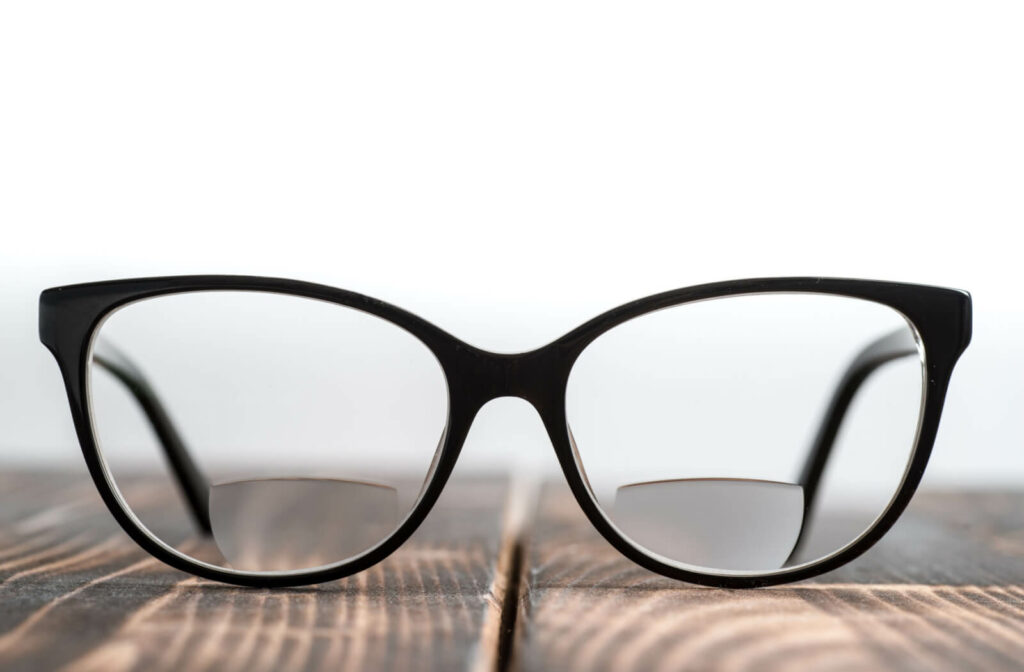When it comes to correcting refractive errors, there are many solutions available. And when dealing with issues like presbyopia, a common solution is bifocal lenses.
These lenses contain 2 different prescriptions within a single lens—one for near vision, and one for distance vision, allowing for convenient vision correction for common age-related refractive errors.
What Are Bifocals?
Bifocals are glasses that feature 2 prescriptions in one lens. The upper portion of the lens corrects refractive errors such as nearsightedness or farsightedness, while the lower portion contains a stronger prescription to correct near vision when reading or writing or using the computer.
The dividing line between the 2 optical powers is called the “bifocal line,” which can be visible or blended, depending on the type of lens. They’re convenient, allowing the wearer to see things up close or far away just by looking through the appropriate part of the lens.

What Conditions Can Bifocals Help Treat?
The eye undergoes many changes from childhood to adulthood. Around age 40, the natural lens in your eye begins to lose its elasticity, making it more difficult to focus on things up close. This refractive error is called presbyopia and happens to everyone as a natural part of aging.
Bifocals are particularly beneficial for those with presbyopia and other refractive errors, such as:
- Myopia, also known as nearsightedness
- Hyperopia, also known as farsightedness
- Astigmatism, a common condition caused by an irregularly shaped lens
Are There Alternatives to Bifocal Lenses?
While bifocals are a popular choice for correcting refractive errors, there are other options available that can also help. Speak with your optometrist before making any decisions on correcting your vision, as they can provide valuable insight and suitable suggestions.
One common alternative to bifocals are multifocal eyeglasses. Multifocals are a broad category of eyeglasses that feature specialty lenses designed to address refractive errors and other vision problems. They offer more than 2 prescriptions in a single lens to address unique and varied vision issues.
Types of Multifocals
Multifocal lenses contain 2 or more prescriptions for correcting vision at varying distances. They include bifocals, trifocals, progressives, and specialty lenses.
- Progressive lenses provide a smooth transition between vision zones, eliminating the distinctive line found in bifocals and providing a more natural view.
- Trifocal lenses have 3 zones for correcting nearby, distance, and in-between vision.
- Occupational progressive lenses are specifically designed to make work and hobby-related tasks easier. They’re optimized for nearby and intermediate distances, making them a good choice for extended computer use, reading, or detailed work.
- Monovision lenses have one eye corrected for nearby vision while the other is corrected for distance.
How to Tell If You Need Bifocals
If you need bifocals, your first step should be visiting your optometrist. They have a great deal of experience in addressing many different vision conditions. They can recommend an appropriate form of treatment for your unique situation.
Through a comprehensive eye exam, they’ll examine your eyes, assess your vision, and check your overall eye health. This will allow them to determine if bifocals are a solution for your vision problems.
Where to Get Bifocals
Visiting your optometrist regularly for comprehensive exams is essential for maintaining your vision. They can monitor any changes that may be developing and help devise an appropriate treatment plan for you. At Prairie Vision, we know that your vision may change with age—but that doesn’t mean it has to be blurry.
Schedule an appointment today to speak with one of our experienced optometrists about bifocals and other potential solutions for your vision!





